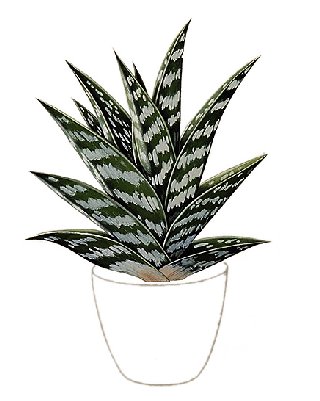

A. aristata (lace aloe), A. brevifolia
(short-leaved aloe), A. nobilis (gold-toothed aloe), A. variegata (tiger
aloe), A. vera (true aloe)
Aloes were grown as pot plants at least
as long ago as the days of the Roman Empire. The chief species in ancient
times was the true aloe, cultivated then as now for the soothing ointment
that can be made from the juice of its leaves. All of the aloes described
here produce rosettes of succulent leaves that resemble those of the century
plant. The plants often bear clusters of small tubular red, orange or yellow
flowers in winter.
The lace aloe forms a rosette, 4 to 6
inches across, containing as many as a hundred 4-inch slender dark green
leaves that are studded on the back with white dots called tubercles. The
short-leaved aloe grows 3 to 4 inches across and has 3- to 4-inch pale
green leaves that are edged with small teeth. The 6- to 10-inch gold-toothed
aloe has pale green leaves with prickly teeth along their edges. The tiger
aloe is the most attractive species for use as a house plant. The leaves,
which eventually form a mound nearly 12 inches tall and 6 inches across,
are accented by bands of white and may eventually become tinted with bronze
if they grow in bright light. The true aloe has pale green leaves 18 to
20 inches long. Old plants of this species become too large for most indoor
locations and should be discarded, but new plants are easy to propagate.
HOW TO GROW. Aloes do best where
they get four or more hours a day of direct sunlight, or where artificial
and natural light average 1,000 foot-candles over 12 hours a day, but they
will grow fairly well in bright indirect light, such as that reflected
from light walls. Night temperatures of 50° to 55° and day temperatures
of 68° to 72° are ideal. Allow the soil to become moderately dry
between thorough waterings. Do not fertilize newly potted plants for the
first year; established plants should be fed once each fall with standard
house-plant fertilizer diluted to half the minimum strength recommended
on the label. Repot overcrowded plants at any season, but be especially
careful not to set aloes any deeper than they grew previously. For best
results use a mixture of 1 part loam, 1 part leaf mold, 1 part sharp sand
and 1/2 part crushed charcoal, or else use a mixture of equal parts of
any packaged general-purpose potting soil and sharp sand; to each gallon
pailful of whichever of these mixtures you use, add 1 tablespoon of ground
limestone and 1 tablespoon of bone meal. Propagate at any season from the
young shoots, or suckers, that spring up from the base of larger plants.
Generally pest free.